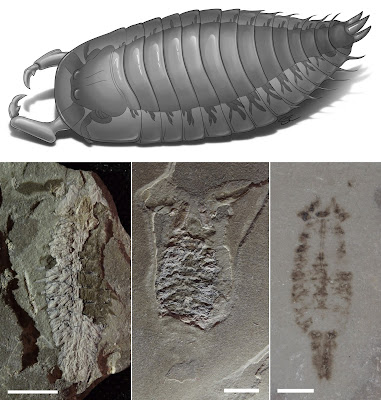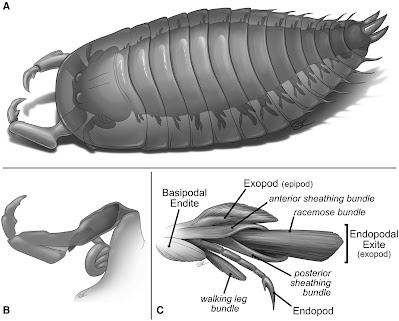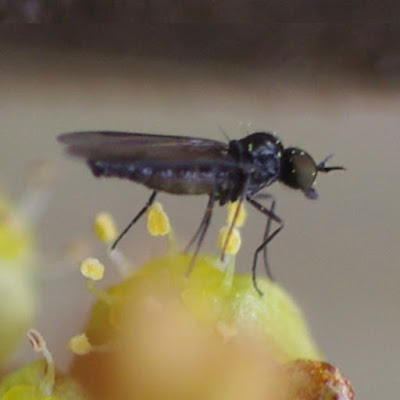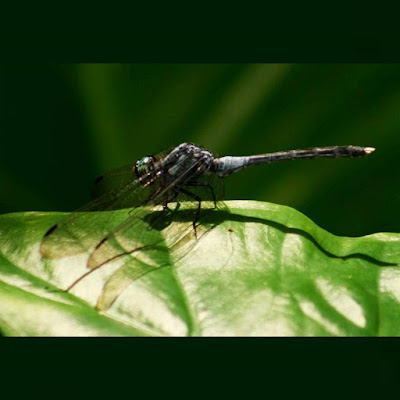[Most Recent Entries] [Calendar View]
Tuesday, May 18th, 2021
| Time | Event | ||
| 1:40a | [Paleontology • 2021] Parioscorpio venator • Stranger than A Scorpion: A Reassessment of A problematic Arthropod from the Llandoverian Waukesha Lagerstätte, Wisconsin, USA
Abstract A relatively uncommon arthropod of the Waukesha lagerstätte, Parioscorpio venator, is redescribed as an arthropod bearing a combination of characters that defy ready classification. Diagnostic features include sub‐chelate ‘great appendages’, a lack of antennae, multiramous anterior trunk appendages, filamentous fan‐like rear trunk appendages, and apparently thin and poorly preserved pleural fields. Phylogenetic analysis resolves this organism as basal to crown‐group Mandibulata and Chelicerata, but its exact placement is inconclusive. Thus, we compare its morphology to several stem groups of arthropods in a discussion of its plausible taxonomic affinities. The examined specimens are probably carcasses and preserve a variety of soft‐tissue details, including muscle blocks in the head, eyes and eye facets, likely ventral nerve cords, a central gut tract and trunk legs with multiple filamentous elements organized into stiff bundles. The preservation habits of P. venator are characterized and compared to previous assessments of Waukesha lagerstätte taxa. Four preservation habits are observed: a phosphatized habit showing flattened to partly three‐dimensional mineralization in francolite; a mouldic habit largely left behind by removed francolite that shows no carbon enrichment despite a darkened colour; sheet‐like or speckled carbonaceous compressions; and scattered pyrite crystals. This redescription highlights both the palaeobiological value of ‘small’ lagerstätten typical of the middle Palaeozoic and the caution that must be taken when interpreting their more enigmatic constituents. Keywords: stem‐group Arthropoda, taphonomy, phosphatization, nerve cord, appendage, morphology, tagma Evan P. Anderson, James D. Schiffbauer, Sarah M. Jacquet, James C. Lamsdell, Joanne Kluessendorf and Donald G. Mikulic. 2021. Stranger than A Scorpion: A Reassessment of Parioscorpio venator, A problematic Arthropod from the Llandoverian Waukesha Lagerstätte. Palaeontology. DOI: 10.1111/pala.12534 Genus Parioscorpio gen. nov. Etymology. From Latin, pario, progenitor, and scorpio, scorpion. Parioscorpio venator gen. et sp. nov. Etymology. From Latin, venator, hunter. Types. Holotype, University of Wisconsin Geology Museum, Madison, Wisconsin, UWGM 2162. Paratype, UWGM 2163. Location. Waukesha Lime and Stone Company west quarry, north of State Highway 164, Waukesha, Wisconsin, USA. Horizon. Lower part of the Brandon Bridge Formation (Silurian: Llandovery, Telychian). Andrew J. Wendruff, Loren E. Babcock, Christian S. Wirkner, Joanne Kluessendorf and Donald G. Mikulic. 2020. A Silurian ancestral scorpion with fossilised internal anatomy illustrating a pathway to arachnid terrestrialisation. Scientific Reports. 10: 14. DOI: 10.1038/s41598-019-56010-z | ||
| 2:18a | [Entomology • 2021] World Revision of Iteaphila (Diptera: Empidoidea: Iteaphilidae) with unbranched radial vein Abstract Iteaphila Zetterstedt is redefined to include species with both branched and unbranched radial vein (R4+5) on the basis of a morphological cladistic analysis and parsimony analysis of COI mitochondrial DNA barcode sequences. As a result, Anthepiscopus Becker is hypothesized as a junior synonym of Iteaphila and species of the Iteaphila setosa group are transferred to the new genus, Paraiteaphila gen. nov. The following new combinations are proposed: P. arundela (Shamshev & Sinclair, 2009) comb. nov., P. caucasica (Shamshev & Sinclair, 2009) comb. nov., P. italica (Loew, 1873) comb. nov., P. kubaniensis (Shamshev & Sinclair, 2009) comb. nov., P. merzi (Shamshev & Sinclair, 2009) comb. nov. and P. setosa (Bezzi, 1924) comb. nov. These two genera are assigned to the family Iteaphilidae stat. rev. Thirty-five species of Iteaphila with unbranched radial vein are revised, including 26 new species: bulbosa species group (I. beringiensis sp. nov., I. bifida sp. nov., I. recta sp. nov., I. tribulosa sp. nov.), macquarti species group (I. bartaki sp. nov., I. falki sp. nov., I. kyrgyzstanensis sp. nov., I. ribesii (Becker, 1891) comb. nov.), nitidula species group (I. longiphallus sp. nov.), nupta species group (I. arnaudi sp. nov., I. bayarea sp. nov., I. brooksi sp. nov., I. dichoptica sp. nov., I. flavipilosa (Coquillett, 1900) comb. nov., I. glabricula sp. nov., I. gracilis sp. nov., I. grandis sp. nov., I. lolo sp. nov., I. longipalpis (Melander, 1928) comb. nov., I. luteitibia sp. nov., I. nupta (Melander, 1928) comb. nov., I. sierrensis sp. nov., I. spinosa sp. nov., I. subnupta sp. nov.), oedalina species group (I. aktruensis sp. nov., I. incus sp. nov., I. miranda sp. nov., I. oedalina (Zetterstedt, 1838) comb. nov., I. polygyna (Melander, 1928) comb. nov., I. recurvata sp. nov., I. sakhalinensis sp. nov., I. zontaki (Nowicki, 1871) comb. nov.), stentor species group (I. parastentor sp. nov., I. stentor (Melander, 1902) comb. nov.) and unplaced to species group (I. caelebs (Becker, 1891) comb. nov.). The following new synonyms are proposed: I. flavicoxa (Melander, 1928) is a junior synonym of I. polygyna (Melander, 1928); I. hirsutus (Melander, 1928) is a junior synonym of I. oedalina (Zettersedt, 1838). Lectotypes are designated for the following species: I. flavipilosa, I. fraternella Zetterstedt, I. nigra Zetterstedt, I. nupta, I. oedalina, I. polygyna and I. ribesii. All species of Iteaphila with unbranched R4+5 are described, key to species presented, male terminalia illustrated, distributions plotted and flowers visited by these species are listed. COI mitochondrial DNA barcode sequences were obtained for 18 identified Nearctic species of Iteaphila with both branched and unbranched R4+5. Keywords: Diptera, Anthophily, Anthepiscopus, dance flies, DNA barcodes, Europe, Iteaphila group, Iteaphila setosa group, Japan, Kyrgyzstan, Mongolia, North America, Russia, family status revised, new genus, new species Bradley J. Sinclair and Igor V. Shamshev. 2021. World Revision of Iteaphila with unbranched radial vein (Diptera: Empidoidea: Iteaphilidae). Zootaxa. 4968(1); 1–89. DOI: 10.11646/zootaxa.4968.1.1 | ||
| 8:23a | [Entomology • 2020] Orthetrum andamanicum • A New Species of Orthetrum Newman, 1833 (Odonata: Libellulidae) from the Andaman Islands, India Abstract Orthetrum andamanicum sp. nov. (holotype ♂: India, Andaman and Nicobar Islands, South Andaman island, Chidiyatapu, N 11.51, E 92.71; 08-xii-1998; deposited in RMNH, Leiden; RMNH.INS.1152911), is described as new to science. Based on additional photographic records, notes on mature males’ life colouration, distribution and habitat of this Andaman endemic are provided. Keywords: Odonata, Orthetrum, endemic, new species, Andaman and Nicobar Islands, biogeography Orthetrum andamanicum sp. nov. M. Bedjanič, V.J. Kalkman and K.A. Subramanian. 2020. A New Species of Orthetrum Newman, 1833 (Odonata: Libellulidae) from the Andaman Islands, India. Zootaxa. 4779(1); 91–100. DOI: 10.11646/zootaxa.4779.1.6 |
| << Previous Day |
2021/05/18 [Calendar] |
Next Day >> |










